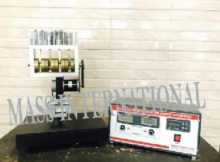TOM 12 BALANCING OF RECIPROCATING MASSES
DESCRIPTIONThis demonstration type of Balancing of reciprocating Masses apparatus consists of a model of a 4 - cylinder engine mounted on a circular cantilever. The Motor, which is connected below the model, drives the crankshaft, which is divided, in four sections, by using belt & pulley system. These cranks through connecting rods operate Pistons made of M.S. and these pistons have a tapping on its top end so as to add additional masses. The entire assembly is mounted on a Sturdy bracket, which is fixed to the main frame. The effect of unbalance due to the reciprocating masses is observed on the vibrations of the frame. The balancing of In-line 4 Cylinder engine with identical. The bending of support arm will be due to unbalanced forces and twisting of the arm will be due to unbalanced couples. Strain gauges are mounted on the cantilever beam to measure the lateral and traverse vibrations.
- • To study and observe the effect of unbalanced reciprocating masses using a flat crankshaft. (Inline Engine)
- • To study the effect of unbalanced reciprocating masses by changing crankshaft angles.
- • Reciprocating parts can be demonstrated with the help of this model.

- • A Four-cylinder engine model.
- • Motor of suitable capacity with Belt and Pulley arrangement for fixing the above model (Speed - 3000 rpm)
- • A circular cross sectional cantilever for mounting the entire assembly of Model and Engine
- • Instrumentation consists of RPM Indicator, Strain Gauge Indicator, On/Off switch etc
An instruction manual is supplied with the apparatus describes theory involved, range and Producer of experiments.
ABOUT OUR COMPANY
WE MANUFACTURERS WIDE RANGE OF PRODUCTS LIKE HEAT TRANSFER LAB EQUIPMENT, HYDRAULIC BENCH, HYDRAULIC MACHINES LAB EQUIPMENT, ETC. WE MANUFACTURE THESE PRODUCTS AS PER THE LATEST MARKET TRENDS AND DELIVER THESE AT USERS’ PREMISES WITHIN THE SCHEDULED TIME FRAME.
Contact Us
Have questions, comments or just want to say hello:
- mass_international99@yahoo.co.in
- 92156-00789 , 9215900789, 9812225689, 9812200689
- Regd. Office Works:
Plot No. 459, Sector – 2, Phase – 1, Industrial Estate Growth Centre,HSIIDC, Saha – 133104
GSTIN. No. 06ADYPK5042P1ZS
Website Design By | Design: Fame Digital Worlds by Fame Digital Worlds
